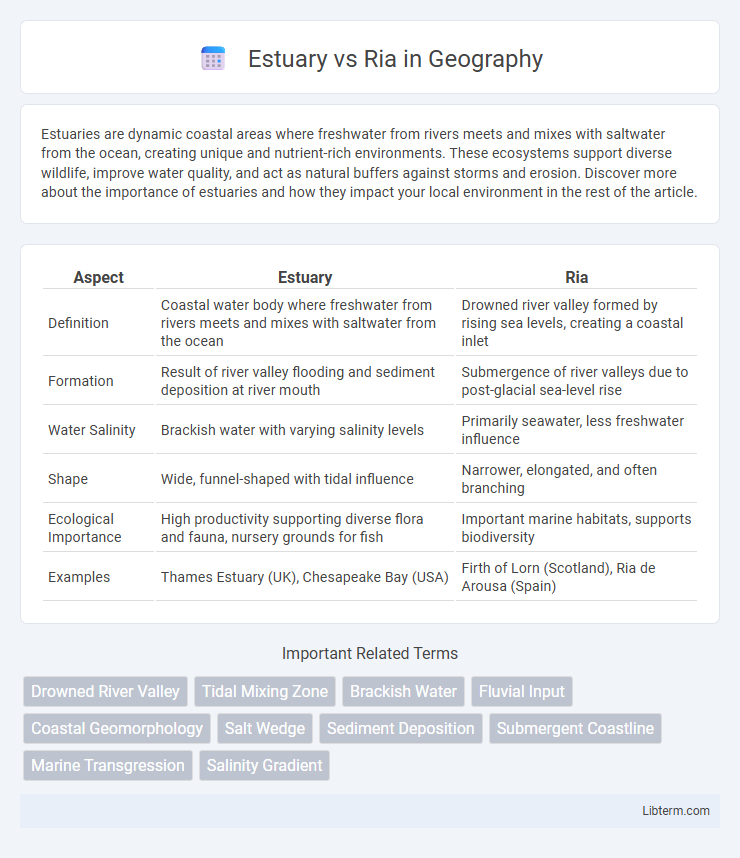Estuaries are dynamic coastal areas where freshwater from rivers meets and mixes with saltwater from the ocean, creating unique and nutrient-rich environments. These ecosystems support diverse wildlife, improve water quality, and act as natural buffers against storms and erosion. Discover more about the importance of estuaries and how they impact your local environment in the rest of the article.
Table of Comparison
| Aspect | Estuary | Ria |
|---|---|---|
| Definition | Coastal water body where freshwater from rivers meets and mixes with saltwater from the ocean | Drowned river valley formed by rising sea levels, creating a coastal inlet |
| Formation | Result of river valley flooding and sediment deposition at river mouth | Submergence of river valleys due to post-glacial sea-level rise |
| Water Salinity | Brackish water with varying salinity levels | Primarily seawater, less freshwater influence |
| Shape | Wide, funnel-shaped with tidal influence | Narrower, elongated, and often branching |
| Ecological Importance | High productivity supporting diverse flora and fauna, nursery grounds for fish | Important marine habitats, supports biodiversity |
| Examples | Thames Estuary (UK), Chesapeake Bay (USA) | Firth of Lorn (Scotland), Ria de Arousa (Spain) |
Introduction to Estuaries and Rias
Estuaries are coastal water bodies where freshwater from rivers mixes with saltwater from the ocean, creating unique brackish ecosystems rich in biodiversity. Rias are drowned river valleys flooded by rising sea levels, characterized by their elongated, funnel-shaped inlets with deep waters and steep sides. Both estuaries and rias serve as critical habitats for marine life and act as natural buffers protecting inland areas from storms and erosion.
Defining Estuaries: Key Characteristics
Estuaries are coastal water bodies where freshwater from rivers meets and mixes with saltwater from the ocean, creating unique brackish environments rich in nutrients and biodiversity. They often feature tidal influences, varying salinity gradients, and sediment deposition zones essential for diverse aquatic habitats. Unlike rias, which are submerged river valleys formed primarily by rising sea levels, estuaries are characterized by their dynamic ecological processes and complex water circulation patterns.
Understanding Rias: Formation and Features
Rias are coastal inlets formed by the partial submergence of river valleys due to rising sea levels, creating long, narrow passages with branching tributaries. These features typically have a dendritic coastline with a deeper channel and gently sloping sides, distinguishing them from estuaries that are primarily influenced by tidal mixing and freshwater flow. Understanding rias involves recognizing their geological origins, which result in sheltered bays rich in marine biodiversity and often serve as natural harbors.
Geological Origins: Estuary vs Ria
Estuaries form where freshwater rivers meet and mix with saltwater from the ocean, characterized by their tidal influence and sediment deposits shaping the landscape over time. Rias are drowned river valleys created by rising sea levels flooding the river valleys, resulting in deep, narrow inlets with steep sides. The geological origin of estuaries involves fluvial processes and sediment accumulation, while rias primarily result from post-glacial sea-level rise submerging existing valleys.
Hydrological Differences Between Estuaries and Rias
Estuaries are coastal water bodies where freshwater from rivers mixes with seawater, creating a brackish environment with distinct salinity gradients and tidal influences. Rias are drowned river valleys flooded by rising sea levels, characterized by deeper, stratified waters and typically exhibit less freshwater inflow compared to estuaries. The primary hydrological difference lies in estuaries having significant freshwater input driving salinity stratification, while rias exhibit deeper seawater dominance with limited freshwater mixing.
Ecological Significance of Estuaries and Rias
Estuaries serve as critical nurseries for many marine species, providing a unique brackish water environment where freshwater meets seawater, supporting high biodiversity and nutrient cycling. Rias, formed by submerged river valleys, create sheltered coastal habitats that harbor diverse plant and animal communities while acting as natural buffers against storm surges. Both estuaries and rias play vital roles in maintaining ecological balance by filtering pollutants, supporting fisheries, and sustaining migratory bird populations.
Sediment and Salinity Variations
Estuaries exhibit dynamic sediment deposits influenced by tidal mixing and riverine inputs, resulting in varying sediment textures and concentrations that impact coastal ecosystems. Salinity gradients in estuaries fluctuate markedly due to the mixing of freshwater and seawater, creating brackish conditions critical for diverse aquatic species. In contrast, rias, as drowned river valleys, typically have more stable sedimentation patterns and salinity levels influenced predominantly by seawater ingress and less freshwater dilution.
Examples of Famous Estuaries and Rias Worldwide
Famous estuaries include the Chesapeake Bay in the United States, the Thames Estuary in the United Kingdom, and the Amazon River Estuary in Brazil, known for their rich biodiversity and vital economic importance. Well-known rias include the Ria de Arousa in Spain, the Bay of Fundy in Canada, and the Milford Sound in New Zealand, celebrated for their scenic fjord-like landscapes formed by drowned river valleys. These distinct coastal formations support diverse ecosystems and offer critical habitats for marine and bird species globally.
Human Impact and Utilization
Estuaries face significant human impact through urbanization, pollution, and industrial activities that alter water quality and biodiversity, while rias, formed by submerged river valleys, often experience tourism development and fishing pressures impacting their fragile ecosystems. Both estuaries and rias serve as crucial sites for shipping ports, aquaculture, and recreation, but estuaries typically have higher nutrient fluxes due to river inputs, making them more susceptible to eutrophication from agricultural runoff. Effective management strategies for estuaries and rias must balance human utilization with conservation to sustain fisheries, water quality, and habitat integrity.
Conclusion: Distinguishing Estuary from Ria
Estuaries are coastal water bodies where freshwater from rivers meets and mixes with saltwater from the ocean, characterized by tidal influence and significant ecological productivity. Rias are drowned river valleys formed by rising sea levels, typically featuring deeper, funnel-shaped inlets without the extensive mixing and sediment deposition seen in estuaries. Understanding these distinctions aids in coastal management, biodiversity conservation, and habitat restoration efforts.
Estuary Infographic

 libterm.com
libterm.com